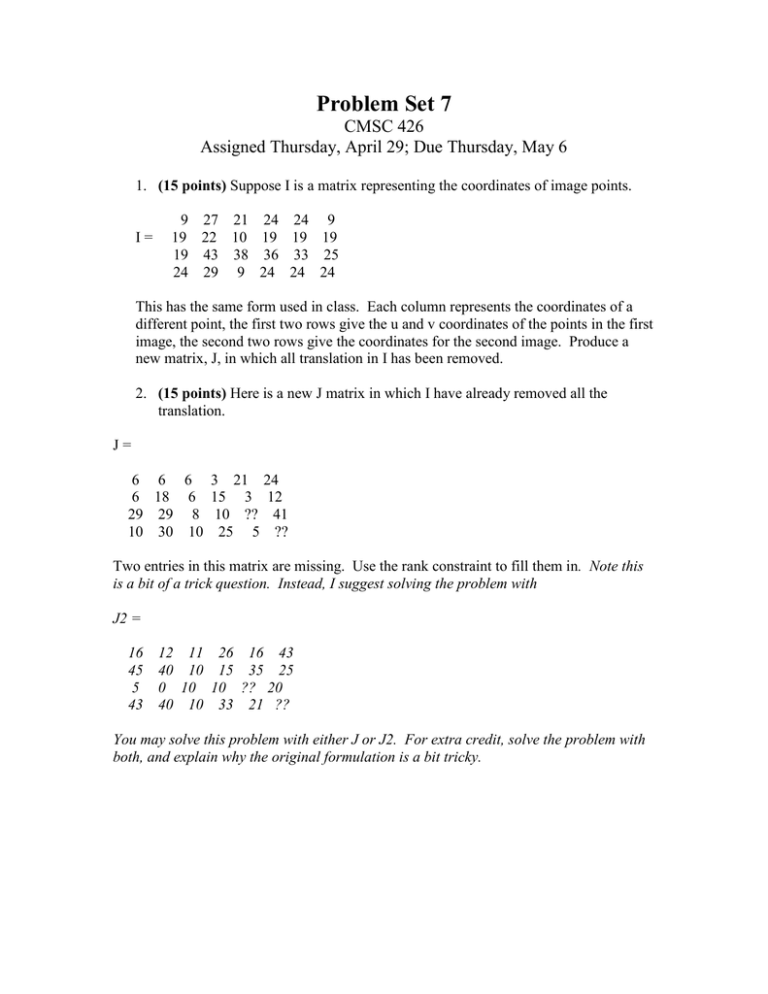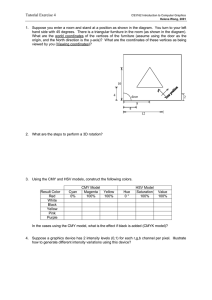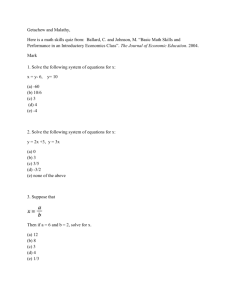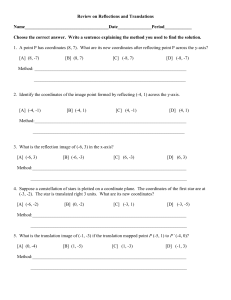Problem Set 7 CMSC 426
advertisement

Problem Set 7 CMSC 426 Assigned Thursday, April 29; Due Thursday, May 6 1. (15 points) Suppose I is a matrix representing the coordinates of image points. I= 9 27 21 24 24 9 19 22 10 19 19 19 19 43 38 36 33 25 24 29 9 24 24 24 This has the same form used in class. Each column represents the coordinates of a different point, the first two rows give the u and v coordinates of the points in the first image, the second two rows give the coordinates for the second image. Produce a new matrix, J, in which all translation in I has been removed. 2. (15 points) Here is a new J matrix in which I have already removed all the translation. J= 6 6 6 3 21 24 6 18 6 15 3 12 29 29 8 10 ?? 41 10 30 10 25 5 ?? Two entries in this matrix are missing. Use the rank constraint to fill them in. Note this is a bit of a trick question. Instead, I suggest solving the problem with J2 = 16 45 5 43 12 11 26 16 43 40 10 15 35 25 0 10 10 ?? 20 40 10 33 21 ?? You may solve this problem with either J or J2. For extra credit, solve the problem with both, and explain why the original formulation is a bit tricky. 3. (15 points) Here is another new matrix J in which I have removed all the translations. J= 21 0 24 6 9 18 0 18 12 15 0 18 34 15 41 26 21 u 0 30 20 25 0 v Two entries are missing, denoted by u and v. Write an equation that describes the location that (u,v) must have in the second image. Why can’t we just use the rank constraint to fill them in, as we did with problem 2? . Note this is a bit of a trick question. Instead, I suggest solving the problem with J2 = 54 10 30 46 47 45 40 47 47 44 35 48 0 30 35 45 40 40 10 u 20 34 57 v You may solve this problem with either J or J2. For extra credit, solve the problem with both, and explain why the original formulation is a bit tricky. 4. (15 points) Here is another new J matrix in which I have removed all translation: J= 9 15 12 6 6 15 9 3 21 3 15 21 21 20 37 29 32 20 15 5 35 5 25 35 15 25 20 10 10 25 21 3 49 31 47 21 Using singular value decomposition (svd in MATLAB), factor J into two matrices, S and P, so that J = S*P. P will be a matrix representing possible 3D coordinates of points, so it should be 3x6. 5. (10 points) Below are two image matrices, I1 and I2. These have not had translation removed; they may contain translation. I1 = 6 24 12 9 15 15 25 22 7 13 25 16 15 45 17 31 30 27 34 29 4 14 34 19 I2 = 7 37 17 34 39 8 32 28 8 13 21 5 12 38 16 29 22 38 32 17 22 25 20 13 Determine whether it is possible that these are images of the same 3D points. Explain your reasoning. 6. Suppose we have an image, H. The intensity of a pixel in H is given by the equation H(x,y) = x + y. So, for example, the intensity at the point (7,3) is 10. Suppose we create a new image, I, by translating every pixel in H two pixels to the right. So, for example, the intensity in the new image at pixel (7,5) will be the same as the intensity in the old image at (5,5). a. (5 points) What is the image gradient at I(5,6)? b. (5 points) What is the temporal derivative, It, of the image I at (5,6). c. (5 points) Write down the optical flow equation at the position (5,6), which provides a constraint on the motion vector. Show that the true motion satisfies this equation. d. (5 points) Now suppose that the image looks a little different in another region. Specifically, for x,y>10, the image H is described by the equation H(x,y) = 2x + y. However, the motion is still the same, so that even in this region, points move two pixels to the right, and the intensity at (13,15) in image I is equal to the intensity at (11,15) in image H. What is the image gradient at (14,14) in image I? e. (5 points) What is the temporal derivative at (14,14) in image I? f. (5 points) Write down the optical flow equation at the position (14,14). Show that using this equation, and the equation you derived in part c, you can uniquely determine the optical flow.





